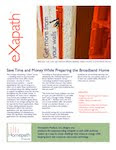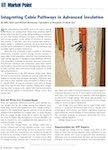Bridging the Gap Between Broadband and Construction™ is ours at Homepath Products and here is why.
We’re adding the ability to change wiring as a structural element in energy conserving homes....helping homeowners achieve energy efficiency without compromising their desire for advanced technology.
If ever you have lived in a mature home, a house built before the arrival of telephone, cable TV or the internet, you’re familiar with the various methods of upgrading wires to add modern appliances. Approaches range from completely tearing out sections of lath and plaster, rewiring, and wall repair to others like these:
- Holes drilled in floors to pass wires through
- Wires running along exterior walls before entering the home
- Wires stapled to interior walls
- Surface mounted raceways hiding wires
- Crown moldings and chair railings hiding wires
- Wires run beneath carpets and area rugs
- Wires “fished” through insulation within walls
If you’re fortunate to live in a home that has permanent “structured wiring” for today’s electronics, security, and data systems, you enjoy seamless connectivity and ease when it comes to adding new consumer electronics. That is, of course, until you find yourself adding a new gadget where one was not planned or, perhaps, when making the inevitable upgrade to the structured wiring driven by the latest “gotta have” gear. Technology does not stand still.
An Emerging Challenge for Homeowners
When designing, building new, or remodeling, focus has shifted toward pragmatic long-term value with less emphasis on cosmetics. Spaciousness is taking a back seat to efficient use of smaller spaces providing more value and utility per cubic foot. An example of this is heightened interest in design for energy conservation. Building smaller to minimize energy required plus the use of highly efficient systems to manage the inside environment. By taking a conservational approach, homeowners see benefit in permanently reduced HVAC costs with low annual maintenance and operational expenses. Occupants experience the intangible perks of living a less cluttered life while society benefits through cumulative reduction in greenhouse gas emissions and delayed climate change. The trend is to simplify and focus on qualitative rather than accumulative living.
Compared to traditional HVAC methods, homeowners opt for new approaches like geothermal heating. The initial cost for such technology is higher with investment justified by weighing installed cost against permanent reductions in energy consumption (30 to 40% more efficient) and reduced annual operating expense.
The Gap
Energy conserving homes use modern forms of insulation like expanding Polyurethane sprayfoam. This material is sprayed into the open wall cavities during construction where it rapidly expands, filling all voids and adhering to all surfaces leaving little opportunity for energy-sapping air infiltration. Unlike traditional forms of insulation, sprayfoams do not degrade or sag with time so their benefits are lasting. The new materials perform well at what they were engineered for but inadvertently add hurdles for future wiring upgrades. When first occupying a space this is not obvious, but it becomes so as the first change is required. “Fishing” wires through tight insulation is time consuming, costly and destructive. A real gap exists between how we design and build and how prepared the homes are to change with the times.
How We Bridge the Gap
Homes are built to stand the test of time, consumer electronics come and go. Knowing this, why do we permanently embed wires within walls? Doing so ignores the likelihood that change will occur well within the lifespan of the structure.
Our aim, at Homepath Products, is to bridge this divide with eXapath. This in-wall system complements best insulation practices while leaving accessible pathways for easy changes to wiring. With it, homeowners can wire where necessary today while leaving the frame of their home ready for change.
Broadband, once a luxury, is now indispensable. The data rates of today’s broadband are the Dial-Up of tomorrow. Technology moves forward at a blistering pace and dramatically faster speeds are being driven to us through our internet providers. The faster they get, the richer our experience becomes, the more frequent we upgrade home systems to support them.
Not only is the eXapath system a breeze to install during construction, it’s equally helpful long after the drywall is up. Unlike traditional conduit systems, eXapath can be located through the drywall using a common stud stud finder. The design lends itself to the addition of new outlets from floor to ceiling without destroying walls, disrupting insulation, or fishing through tight spaces. Providing pathways ensures that the insulation envelope of the home remains intact and efficient for the life of the home. Simple but revolutionary.
If you are building, considering a deep energy retrofit, or major remodel where you will be opening the walls, add eXapath while there and build flexibility for change into your home, value for you to enjoy and pay forward to the next owner.
Does your home bridge the gap?












.jpg)

